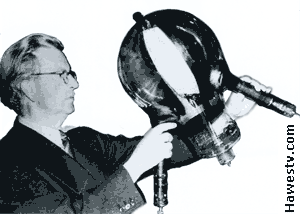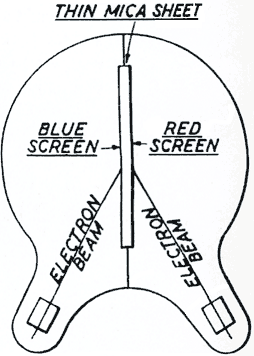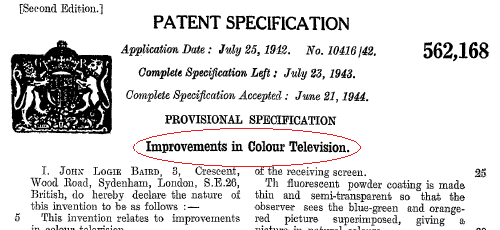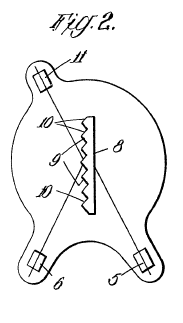| Tweet |
|
Speculation About a “One-Gun” Telechrome
One gun? Sony ads claimed that Trinitron had only one gun. (Actually, this statement was subterfuge, because Trinitron's “one gun” had three cathodes.) Here's where the dreamers drift off again. (A little reader participation is necessary here. Gesticulate wildly, raise your eyebrows and read the next passage aloud in a breathy voice.)
But if one can say that Trinitron had one gun, and if Baird was thinking about a one-gun Telechrome, why then...
Fables. Peter Waddell (1976) carries the torch for such Baird fables. Channeling Baird, Waddell strains credibility with this statement (p. 344)...
One of his [Baird's] assistants, Edward Anderson, states that they had the equivalent of the Sony “Trinitron” tube on the drawing board at that time. Baird's colour equipment vanished after his death. (p. 344)
Equivalent? In what sense? On what drawing board? Whose drawing board? Where is the evidence? This much we know: Sony did manufacture Trinitrons. Millions of them. Yet is there a one-neck or one-gun Telechrome tube anywhere? No. “Baird's color equipment vanished.” How convenient. Whenever Baird fanatics make an outlandish claim, the supporting documents, prototypes and even physics disappear into a conspiracy. But let's consider the merits. Below, we hold these spurious claims up to the light.
|
|
|
Flaws That Relate to the Trinitron
Missing Pieces. The Telechrome patent (Baird, 1942) fails to include several structures that distinguished the Trinitron tube from other CRTs, including Telechrome. Missing from Telechrome were these structures...
- The aperture mask.
- A single target with alternating, vertical stripes of red, green and blue phosphor.
- An electron gun with three cathodes and a single focusing magnet.
- A single neck. (Baird might have invented a one-neck gun, but his Telechrome patent doesn't claim this feature.)
- A bell-shaped envelope with a cylindrical front end.
- The requirement of a straight neck. (Typically, Baird's Telechrome tubes used at least one slanted neck. In contrast, Trinitron was a straight-neck tube.)
Exhibit B: Telechrome Internals
The trick would be to join two teapots at the target. The resulting tube would have two standard teapot necks, each at an angle to the target. Then assuming a transparent target, Baird might coat one side with one color phosphor. The other side, he would coat with a second color. Suppose that, as in industry practice, he chose cyan and red for the two colors: Then the tube would produce color pictures! He would alternately scan the targets, producing field-sequential images.
Baird's notes on the specifics seem to be missing or imprecise. (No wonder: He was operating from scant funds in a makeshift shop. During the war, he persisted in his efforts despite frequent bombardment by Nazi planes.) From Herbert's description (1996), we might assume that the unknown electrode voltages match those of the original teapot tube (p. 26). Perhaps someone will duplicate a two-color Telechrome using teapot electronics. Then we can find out more about its behavior. Hint: In 1942, the Chicago company Rauland bought the rights to the teapot tube. This company continued to develop the tubes. McVoy (2014) provides photos and a description of the Rauland teapot tube. Rauland literature might still be available. (Erb, 2014)
Exhibit C: What Witnesses Said
Press Coverage. Herbert (1996) describes the Telechrome press conference in August 1944. Kludge though Telechrome was, the two-color behemoth worked. The natural flesh tones impressed some of the reporters. Telechrome must have seemed a respite from reporting terrible news of World War II. No doubt this escapism is a reason why newspaper articles cast Telechrome in mostly favorable light.
Technical account. Burns (2000) mentions an earlier Baird demonstration for technical people. This January 1944 meeting resulted in a more sober impression of Telechrome. Afterward, observers decried the unnatural two-color palette. Continuing, the January report criticized 3D Telechrome as a “stunt.” (pp. 379-380)
|
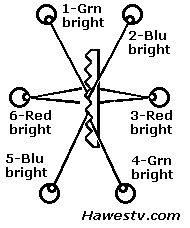
Position sensitivity: Viewing angle affects apparent color brightness. |
| |
Was Telechrome a Trinitron tube?
How might they differ? Many differences are obvious. Baird's preferred Telechrome was a two-color picture tube. Trinitron was a three-color tube. The Telechrome of Baird's preferred implementation was a tube with two targets. It scanned one color target from left to right. The tube scanned the other color target backwards, from right to left. In contrast, the Trinitron, like the delta-gun tube, had only one target. Trinitron scanned its target only from right to left. (Trinitron scanning took place on the back of the target. For the viewer, the scanning action was actually left to right.) Perhaps most damning for Telechrome, it was never more than what Brian Winston (1998) called a “partial prototype.” On the other hand, Trinitron was a mass-produced tube in TV sets that consumers widely accepted on a worldwide basis.
Let's examine the statement that Telechrome equals Trinitron...
- What relationship did Baird have with Sony? None.
- Is there evidence that Baird ever built a single-neck tube? No.
- Is the number of necks the only characteristic that made a Sony Trinitron? No.
- Was a Telechrome set a simultaneous-color set, like the Trinitron? No.
- Did Telechrome use an aperture grille, as in Trinitron? No.
Debunked
Conclusion: Not so good for the Baird true believers. Plain and simple: Pseudoscience just beguiled you. Telechrome wasn't a Trinitron tube by any stretch. Telechrome wasn't a precursor to Trinitron in any meaningful way. Telechrome was in fact an evolutionary dead end. What it teaches about Trinitron is this: Posthumous inventions remain impossible, even for John Logie Baird.
Aren't there any similarities between the tubes? There are very few. Please examine the tables below.
Telechrome vs. Trinitron, Part 1
| Tube | Aperture Grille | No. of targets | Color Mode | No. of Colors | Front contour, tube | Color emitter | Deflection | Flicker |
| Trinitron | Yes | 1 | Simultaneous | 3 | Slightly cylindrical | Vertical stripes on back of screen | Electromagnetic | Low |
| Telechrome | No | Typ. 2 (or 3) | Field-sequential | Typ. 2 (or 3) | Extremely spherical (bulbous) | Solid planes of color on mica targets deep inside tube | Electromagnetic (probably) | High |
Telechrome vs. Trinitron, Part 2
| Tube | Guns | Target color method | Cathodes per Gun | Interlace | Colors per Field | Market Worthy | World Standard | Adaptable to Other World Standards? |
| Trinitron | 1 | One cylindrical target with vertical color stripes: R-G-B-B-G-R, etc. | 3 | 2:1 | 3 | Extremely popular. Widely produced | NTSC/PAL/SECAM | Yes |
| Telechrome | 2 (or 3) | Multiple flat targets, each with solid color coat | 1 | 3:1 (each screen)1 | 1 | Never produced. Prototypes only. Industry reject.2 | Proprietary | Yes, but only with increased flicker.3 |
Notes
- Total: 6 scans for 2-color version. For 6 scans, frame rate is only 50/6, or 8.3 Hz. Possibly more scans and even lower frame rate for 3-color version. In large areas of color, flicker would be unbearable. As means of coping with problem, Baird proposed line-sequential scanning. (Baird Patent 562,334, p. 1) According to Burns (2000), Baird probably didn't pursue line-sequential television. (See pp. 376-377.)
- No evidence of practical tube. 1-gun (or 1-neck) tube has never turned up. No museum has one.
- To work on 3-color world standards, 2-color version requires color-translation circuits.
Some Incidental Differences
Necks. Trinitron tubes had relatively short necks. In contrast, Telechrome tubes had long necks. On multi-neck Telechrome tubes, each color neck had a separate filament, cathode and grid or grids (control, screen and focus).
Envelopes: Bulbous vs. Cylindrical. There were differences in the tube envelopes. The front of the Telechrome tube was bulbous and it projected outward. This projection of the front (or rear) glass functioned as a crude lens. The lens distorted the image from the interior screen. To correct such 'fishbowl' distortion, a later Baird patent suggested flatter viewing surfaces. (Baird patent 562,433, p. 1) On the other hand, Trinitron painted pictures on the back of its screen. Although the screen profile was cylindrical, distortion was minimal.
Envelopes: Dag. Unlike Trinitron, Telechrome didn't have an exterior coating of aquadag (dag.) Since dag is opaque, it would impede the view into the Telechrome CRT. In photos, one can see the targets from several angles. A dag coating would obscure most of these views. Another difference was the anode connection. The Trinitron anode connected through a standard cap in the side of the tube bell. Apparently, the Telechrome anode connected through the Hewittic neck.
Degausser. The Trinitron set included an automatic tube degausser. At set startup, this degausser demagnetized the aperture mask. Telechrome didn't use Sony's aperture mask or anything like it. Possibly the metal supports for the mica targets could become magnetized. (These supports likely served as an anode, because mica isn't a conductor.) That Baird would include an automatic demagnetizer in his experimental design is unlikely.
The Verdict
There were More Differences than similarities between Telechrome and Trinitron. As the tables above prove, there were several key differences between Telechrome and Trinitron. One simply can't arrive at a Trinitron tube by referring to the Telechrome tube or the Baird Telechrome patent (1942). The number of targets differed, as did the neck angle and envelope shape. Unlike Trinitron, Telechrome didn't have an aperture mask. Trinitron sets scanned the colors simultaneously. Telechrome sets scanned the colors field-sequentially.
Disrespect. Baird revisionists that proclaim a connection between Telechrome and Trinitron flagrantly ignore and disrepect the true inventors: Susumu Yoshida, Akio Ohgoshi, Senri Miyaoka and other engineers under Sony president Masaru Ibuka. (Sony, 2014)
Vanished? What about Waddell's statement that “Baird's colour equipment vanished after his death”? Now that doesn't sound like such a mystery anymore. Baird or his associates must have realized that there was no practical use for Telechrome. Outside of a publicity stunt, that is. Fact: Neither Baird nor anyone else ever sold a Telechrome set. It was unmarketable. Then the only way to claim a footnote in color TV history books became clear: Eliminate evidence. And the Telechrome, while it wouldn't fit into a practical TV cabinet, slid nicely into the dustbin. Then the time was right to start improvising whoppers.
The real reason why some people compare Telechrome to the Trinitron is this: The Trinitron was a fabulously popular, successful, widely produced tube. It was highly profitable for Sony and for companies who licensed the tube. Telechrome, on the other hand, was a commercial failure. No one ever produced the tube. In fact, no company even expressed an interest in licensing the Baird Telechrome patents. (Brown, 107) Telechrome's sole purpose was to generate publicity for Baird. Only in this sense did Telechrome succeed. Baird enjoyed his fleeting moment of fame. Today, Baird shills want to parlay this one moment into some form of historic entitlement. But history isn't a matter of entitlement. Instead, history depends on what happened, and public acceptance of what happened. Technical historian Brian Winston (1998) explains this point most eloquently in exquisite detail (pp. 1-15).
Insisting, despite facts, that Trinitron somehow emerged from Telechrome is a way of hitching Baird's wagon to the Trinitron star. Like Telechrome, this ploy is hopeless, pathetic and a footpath to failure.
Bibliography
Abramson, Albert. The History of Television, 1942 to 2000. Jefferson, NC: McFarland, 2003.
Baird, John Logie. "Improvements in Colour Television," G.B. patent 562,168, filed July 25, 1942, and issued June 21, 1944. •Re: Original Telechrome patent.
Baird, John Logie. "Improvements in Colour Television Apparatus," G.B. patent 562,334, filed October 10, 1942, and issued June 23, 1944. •Re: Line-sequential patent. Burns (2000) believes that Baird probably didn't pursue this patent. Reason: Implementation would have been arduous: Might not have been possible with technology of time.
Baird, John Logie. "Improvements in or Relating to Screens for Television," G.B. patent 579,482, filed April 8, 1944, and issued August 6, 1946. •Re: Target insertion into Hewittic envelopes.
Baird, John Logie. "Improvements in Cathode Ray Tubes for Television," G.B. patent 562,433, filed July 23, 1943, and issued June 30, 1944. •Re: Compensating for lens distortion from bulbous screen faces of Telechrome tubes.
Brown, Douglas. The Three Dimensions of John Logie Baird. Bedford, UK: Radio Society of Great Britain), 2012, 107. •Re: Rauland rejected Telechrome. Reason: Telechrome tube's viewing screen was internal, instead of on the face of the tube.
Burns, Russell. John Logie Baird, Television Pioneer. London: The Institution of Electrical Engineers, 2000. (This book is part of the IEE History of Technology series.)
Erb, Ernst, HB9RXQ. "History of the radio manufacturer Rauland Corporation; Chicago," n.d., access on June 7, 2014. http://www.radiomuseum.org/dsp_hersteller_detail.cfm?company_id=3219
Hart, Martin. "Cinecolor," 1998, access on March 6, 2018. http://www.widescreenmuseum.com/oldcolor/cinecolor2.htm
Herbert, Ray. Seeing by Wireless: The Story of Baird Television. Sanderson, Surrey, England: Herbert, 1996.
Kamm, Antony and Malcolm Baird. John Logie Baird: A Life. Edinburgh: National Museums of Scotland, 2002, 326.
McVoy, Steve. "Baird/Rauland Projection CRT," n.d., access on June, 7, 2014. http://www.earlytelevision.org/rauland_crt.html
National Media Museum. "Telechrome Tube: Television Receivers," 2014, access on June 16, 2014. http://www.nationalmediamuseum.org.uk/collection/television/televisionreceivers/collectionitem.aspx?id=1962-48
Rauland. "Company History of Rauland," 2014, access on June 7, 2014. http://www.rauland.com/History.cfm
Shiers, George. Early Television: A Bibliographic Guide to 1940. (Garland Reference Library of Social Science) New York: Routledge, 1996.
Sony. "Superior Quality of Trinitron TV Screens Leads to Computer Display Applications," 2014, access on September 30, 2014. http://www.sony.net/SonyInfo/CorporateInfo/History/SonyHistory/2-14.html
Waddell, Peter. "Seeing By Wireless." New Scientist 11 (1976): 342-344.
Wikipedia "Trinitron," 2014, access on September 30, 2014. http://en.wikipedia.org/wiki/Trinitron#Chromatron Wikipedia article with more information on Trinitron development and the developers. Contrasts the Trinitron to the Lawrence Chromatron. Unfortunately there are several broken links.
Winston, Brian. Media Technology and Society: A History: From the Telegraph to the Internet. New York:
Routledge, 1998. Won the American Association for History and Computing Prize for the Best Book of 1998.
Visit these related pages... |
|||||
|
|
|
||||
Contents
•Speculation About a “One-Gun” Telechrome
•Exhibit A: Flaws in the Telechrome Patent
•Exhibit B: Telechrome Internals
•Exhibit C: What Witnesses Said
•Exhibit D: Alleged 3-color Telechrome
•Was Telechrome a Trinitron tube?
•Speculation About “One-Gun” Telechrome
•Telechrome vs. Trinitron, Part 1
•Telechrome vs. Trinitron, Part 2
